Hole-Carding Blackjack Shoe Games

By Anonymous
|
|
Few who work in table games management and even fewer APs know that blackjack shoe games offer hole-carding opportunities. How could this even be possible? Yet advanced APs know that shoe games have been one of the most reliable sources for hole-carding opportunities over the last 20 years. Hole-carding opportunities do not exist by themselves, ready to be discovered by the astute scout. Rather, in shoe games hole-card opportunities are created by APs. To make these opportunities occur, APs understand subtle principles of blackjack layouts and know how to identify key flaws. Poor layout design together with a lack of awareness allows APs to force dealers to expose their hole-card. In the right circumstances, even skilled dealers can become vulnerable targets.
There are two basic designs for blackjack layouts, pitch layouts and shoe layouts. In a pitch layout there is more room between the betting circles and the lip of the layout on the player’s side. This design gives landing room when the dealer tosses the card towards the players. The action is behind the betting circles. That’s where players receive cards, make hand motions for additional cards, and where players tuck their cards after completing their action. The following pictures illustrate correctly designed pitch layouts:
Hole-carding opportunities arise in shoe games when they are dealt using a pitch layout. With a pitch layout, there is often not enough room left for the dealer to slide his cards in front of the player’s cards.
Here are two examples of shoe games being dealt on pitch layouts. I found these by searching Google images. As you look at each, imagine the challenges the dealer would face if the players had placed their wagers as far forward in the betting circles as possible.
The key to creating a hole-card opportunity in a shoe game dealt on a pitch layout is to restrict the dealer’s corridor for dealing his hole-card so that the dealer moves his hole-card over an obstacle. The targeted obstacle may be the corner of the chip tray. It may be chips stacked to the end of the outside sleeve in the rack. The obstacle may be the peeking device the dealer uses to check for blackjack. In some cases no obstacle is necessary. A dealer who feels sufficiently claustrophobic may simply break procedure and lift the corner of his hole-card.
To squeeze the dealer’s hole-card towards the player’s side of the table, the APs may bring low denomination chips to the table. They will ask to exchange their chips for higher denominations. Their intention is to fill the outside sleeves in the chip tray. For example, the players may say that their chips are from the Poker room. Another strategy is to play at the actual first-base position. On many pitch layouts, this position is nearly eclipsed by the shoe..
To squeeze the dealer’s hole-card away from the player’s side of the table, the APs will position their wagers at the top of their betting circles. For example, a team may occupy each seat around the table, playing forward in each spot.
In other words, the AP team squeezes the dealer towards the player's side by filling the chip tray. They squeeze in the other direction by placing their wagers forward in their betting circles. By squeezing an appropriate amount in each direction, the APs steer the dealer’s hole-card over the targeted obstacle.
The following pictures are screen captures from video footage. In the first picture, note that the top two sleeves of the chip tray are full. Likewise, note that each player’s chips are wagered as far forward as possible in the betting circles. The APs are steering the dealer’s hole card over the blackjack peak device.
The dealer’s hole-card (a four) is clearly visible to the player seated at third base. The spotter at third base sees that the hole-card is a four and signals the information to the big player seated at first base. Note that the big player has a total of 12.
The following picture shows that the dealer’s up-card is a nine. Basic strategy is for the big player to hit his hard 12 against the dealer’s nine. But the big player knows that the dealer’s hole-card is a four, so that the dealer’s current hand total is hard 13. The image below shows that the big player is correctly standing on his hard 12 against the dealer’s hard 13.
As the following picture shows, even though the big player played correct hole-card strategy, he still lost the hand after the dealer hit to 17. Too bad for the hole-card player. But, his stack of black chips shows that he is doing just fine.
Ask yourself these questions:
Many casinos change their tables from shoe to pitch and back, depending on changing market conditions. As a result, it is quite common for the wrong type of layout to be on a blackjack table. A layout is a game protection device. An inappropriate layout exposes the casino to advantage play liabilities. Using the wrong type of blackjack layout is like using edge-sortable cards. As soon as you understand that there is a problem, you can easily take appropriate actions to safeguard the vulnerability.
There are two basic designs for blackjack layouts, pitch layouts and shoe layouts. In a pitch layout there is more room between the betting circles and the lip of the layout on the player’s side. This design gives landing room when the dealer tosses the card towards the players. The action is behind the betting circles. That’s where players receive cards, make hand motions for additional cards, and where players tuck their cards after completing their action. The following pictures illustrate correctly designed pitch layouts:
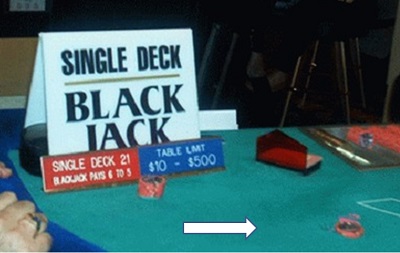
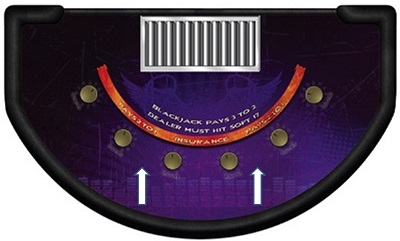
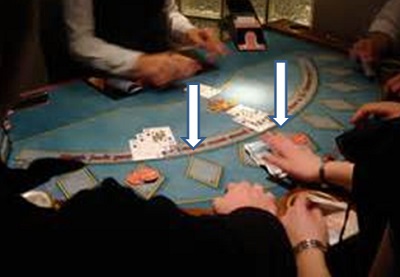
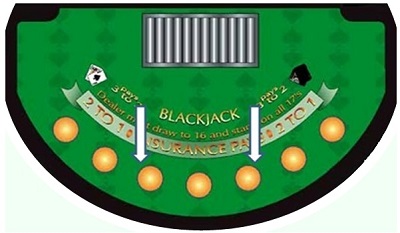
Hole-carding opportunities arise in shoe games when they are dealt using a pitch layout. With a pitch layout, there is often not enough room left for the dealer to slide his cards in front of the player’s cards.
Here are two examples of shoe games being dealt on pitch layouts. I found these by searching Google images. As you look at each, imagine the challenges the dealer would face if the players had placed their wagers as far forward in the betting circles as possible.
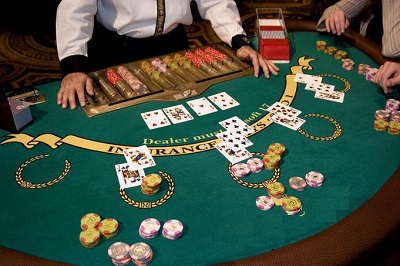
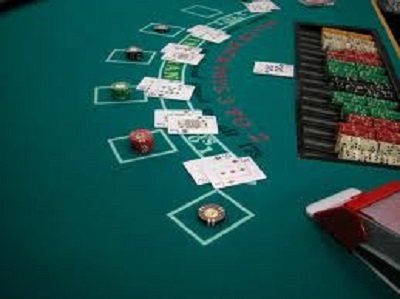
The key to creating a hole-card opportunity in a shoe game dealt on a pitch layout is to restrict the dealer’s corridor for dealing his hole-card so that the dealer moves his hole-card over an obstacle. The targeted obstacle may be the corner of the chip tray. It may be chips stacked to the end of the outside sleeve in the rack. The obstacle may be the peeking device the dealer uses to check for blackjack. In some cases no obstacle is necessary. A dealer who feels sufficiently claustrophobic may simply break procedure and lift the corner of his hole-card.
To squeeze the dealer’s hole-card towards the player’s side of the table, the APs may bring low denomination chips to the table. They will ask to exchange their chips for higher denominations. Their intention is to fill the outside sleeves in the chip tray. For example, the players may say that their chips are from the Poker room. Another strategy is to play at the actual first-base position. On many pitch layouts, this position is nearly eclipsed by the shoe..
To squeeze the dealer’s hole-card away from the player’s side of the table, the APs will position their wagers at the top of their betting circles. For example, a team may occupy each seat around the table, playing forward in each spot.
In other words, the AP team squeezes the dealer towards the player's side by filling the chip tray. They squeeze in the other direction by placing their wagers forward in their betting circles. By squeezing an appropriate amount in each direction, the APs steer the dealer’s hole-card over the targeted obstacle.
The following pictures are screen captures from video footage. In the first picture, note that the top two sleeves of the chip tray are full. Likewise, note that each player’s chips are wagered as far forward as possible in the betting circles. The APs are steering the dealer’s hole card over the blackjack peak device.
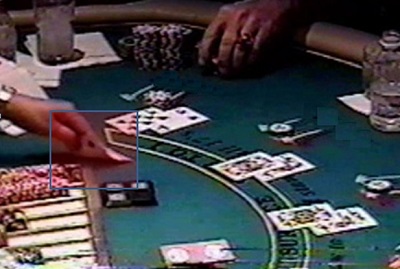
The dealer’s hole-card (a four) is clearly visible to the player seated at third base. The spotter at third base sees that the hole-card is a four and signals the information to the big player seated at first base. Note that the big player has a total of 12.
The following picture shows that the dealer’s up-card is a nine. Basic strategy is for the big player to hit his hard 12 against the dealer’s nine. But the big player knows that the dealer’s hole-card is a four, so that the dealer’s current hand total is hard 13. The image below shows that the big player is correctly standing on his hard 12 against the dealer’s hard 13.
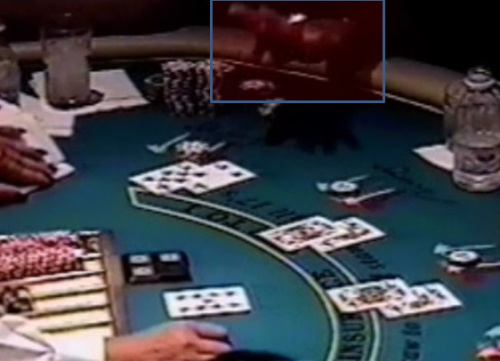
As the following picture shows, even though the big player played correct hole-card strategy, he still lost the hand after the dealer hit to 17. Too bad for the hole-card player. But, his stack of black chips shows that he is doing just fine.

Ask yourself these questions:
- Are you using pitch layouts on your shoe games?
- Is there room for the shoe to rest unobstructed on the first base side of the table?
- Is there an unobstructed path to slide the initial two cards to each of the players?
- Is this shoe position blocking the dealer’s view or any further action by any player at the table?
- Is there ample room for the dealer to deal her hole-card, no matter the position of the player’s wagers or status of the rack?
- Is there room for the dealer to complete her hand even after the players have completed their action?
- Are there any obstructions that could potentially lead to hole-card exposure?
Many casinos change their tables from shoe to pitch and back, depending on changing market conditions. As a result, it is quite common for the wrong type of layout to be on a blackjack table. A layout is a game protection device. An inappropriate layout exposes the casino to advantage play liabilities. Using the wrong type of blackjack layout is like using edge-sortable cards. As soon as you understand that there is a problem, you can easily take appropriate actions to safeguard the vulnerability.


